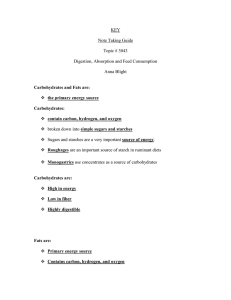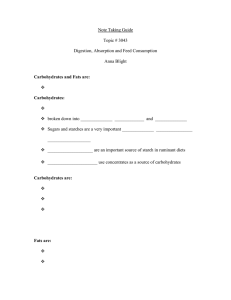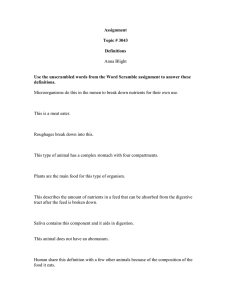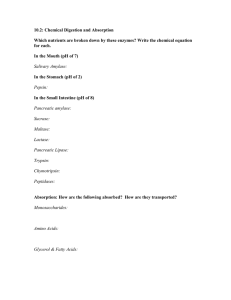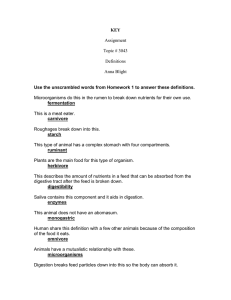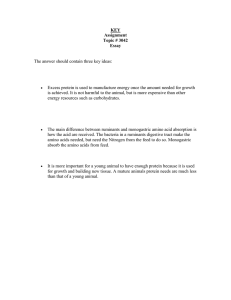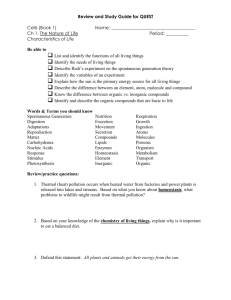Animal Nutrition Topic 3043 Carbohydrates and Fats Digestion, Absorption and Feed
advertisement
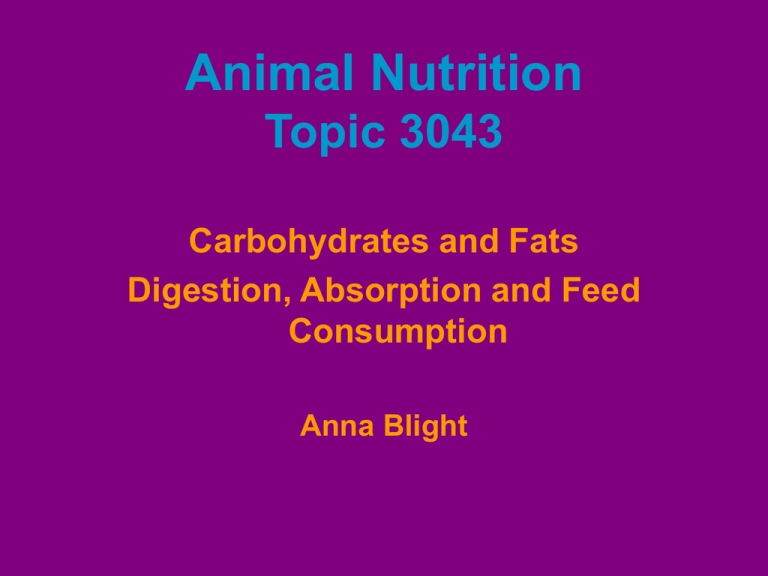
Animal Nutrition Topic 3043 Carbohydrates and Fats Digestion, Absorption and Feed Consumption Anna Blight Carbohydrates and Fats • The primary energy source in feed Carbohydrates • Contains carbon, hydrogen and oxygen • Digestion breaks down carbohydrates into simple starches and sugars Carbohydrates • Sugars and starches are a very important source of energy • Roughages are an important source for starch in ruminant diets (hays and silage, etc.) Carbohydrates • Monogastrics better utilize concentrates (cereal grains, oil meals, soybean meals, etc) as source of carbs. • Concentrates are high in energy • Low in fiber • Highly digestible Fats • Primary energy source • Contains carbon, hydrogen and oxygen • Digestion breaks down fat into fatty acids • 2.25 times more energy / pound than carbohydrates Digestion and Absorption • The role of digestion is to reduce feed particles to molecules • Molecules can be absorbed into the blood and eventually support body functions Digestion and Absorption • Digestibility refers to the amount of various nutrients in a feed, which can be absorbed from the digestive tract • Animals are classified as ruminants or monogastrics Ruminants • Cows, goats and sheep • Rumination = Chew cud • (re-chew a regurgitated bolus of feed) Ruminants • Has a complex stomach consisting of more than one compartment • The four compartments are called rumen, reticulum, omasum and abomasom. Ruminants • The rumen is a large fermentation vat where bacteria and protozoa thrive and break down roughages to obtain nutrients for their own use. • Animal has mutualistic relationship with microorganisms Cattle synthesize B vitamins • Microorganisms in the gut make B-complex vitamins • Can also make some proteins if given correct type of nitrogen • Later these microorganisms are digested in the small intestine to provide nutrients for the animal’s use Fermentation process • Microbial fermentation of carbohydrates produces volatile fatty acids as waste products • Animal uses volatile fatty acids as major source of energy • Also produces large amounts of methane gas and some carbon dioxide Monagastrics • Pigs, horses, poultry and humans • Simple stomach, one compartment • Enzymes present in saliva and in the stomach aid in digestion Monagastrics • Carbohydrates break down into simple starches and sugars • Proteins to amino acids • Fat to fatty acids Monogastrics • Cannot significantly synthesize B-complex vitamins or amino acids • Small intestine receives finished products of digestion • Small intestine is most important area for digestion and absorption of feed
